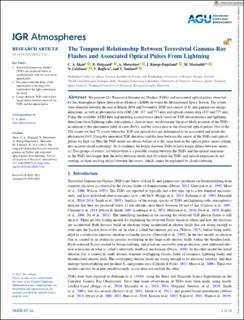| dc.contributor.author | Skeie, Chris Alexander Kallevik | |
| dc.contributor.author | Østgaard, Nikolai | |
| dc.contributor.author | Mezentsev, Andrey | |
| dc.contributor.author | Bjørge-Engeland, Ingrid | |
| dc.contributor.author | Marisaldi, Martino | |
| dc.contributor.author | Lehtinen, Nikolai Grigorievich | |
| dc.contributor.author | Reglero, V. | |
| dc.contributor.author | Neubert, T. | |
| dc.date.accessioned | 2023-03-31T10:32:45Z | |
| dc.date.available | 2023-03-31T10:32:45Z | |
| dc.date.created | 2022-11-14T11:52:17Z | |
| dc.date.issued | 2022 | |
| dc.identifier.issn | 2169-897X | |
| dc.identifier.uri | https://hdl.handle.net/11250/3061381 | |
| dc.description.abstract | We present 221 Terrestrial Gamma-ray Flashes (TGFs) and associated optical pulses observed by the Atmosphere-Space Interactions Monitor (ASIM) on board the International Space Station. The events were detected between the end of March 2019 and November 2020 and consist of X- and gamma-ray energy detections, as well as photometer data (180–230, 337, and 777 nm) and optical camera data (337 and 777 nm). Using the available ASIM data and applying a consistency check based on TGF characteristics and lightning detections from lightning radio atmospherics close in time, we determine the most likely position of the TGFs in relation to the photometer field of view (FoV), and the association to the observed optical pulses. Out of the 221 events we find 72 events where the TGF and optical data are determined to be associated and inside the photometer FoV. Using the measured TGF durations and the time between the onsets of the TGFs and optical pulses we find: (a) That the TGF onsets are always before or at the same time as the optical pulse onsets (taking into account cloud scattering). (b) A tendency for longer duration TGFs to have longer delays between onsets. (c) Two groups of events: (a) where there is a possible overlap between the TGFs and the optical emissions, as the TGFs last longer than the delay between onsets and (b) where the TGFs and optical emissions do not overlap, as there are long delays between the onsets, which cannot be explained by cloud scattering. | en_US |
| dc.language.iso | eng | en_US |
| dc.publisher | Wiley | en_US |
| dc.rights | Navngivelse 4.0 Internasjonal | * |
| dc.rights.uri | http://creativecommons.org/licenses/by/4.0/deed.no | * |
| dc.title | The Temporal Relationship Between Terrestrial Gamma-Ray Flashes and Associated Optical Pulses From Lightning | en_US |
| dc.type | Journal article | en_US |
| dc.type | Peer reviewed | en_US |
| dc.description.version | publishedVersion | en_US |
| dc.rights.holder | Copyright 2022. The Authors | en_US |
| dc.source.articlenumber | e2022JD037128 | en_US |
| cristin.ispublished | true | |
| cristin.fulltext | original | |
| cristin.qualitycode | 2 | |
| dc.identifier.doi | 10.1029/2022JD037128 | |
| dc.identifier.cristin | 2073415 | |
| dc.source.journal | Journal of Geophysical Research (JGR): Atmospheres | en_US |
| dc.identifier.citation | Journal of Geophysical Research: Atmospheres. 2022, 127 (17), e2022JD037128. | en_US |
| dc.source.volume | 127 | en_US |
| dc.source.issue | 17 | en_US |

